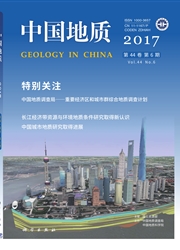

 中文摘要:
中文摘要:
巴什布拉克铀矿床位于新疆喀什凹陷北西部一套陆相碎屑沉积岩中。野外调查发现,伴随铀矿化发育大量地沥青、油气残留物。本文对采自巴什布拉克铀矿床的地沥青含矿砂岩矿石进行了流体包裹体测试和有机地球化学分析.以确定成矿流体的温度和盐度以及成矿物理化学背景,追索有机质的来源,进而探讨矿床成因。镜下观测发现。含矿砂岩中含有大量的油气包裹体,其中以液烃包裹体为主,含有少量气液烃包裹体和含烃盐水包裹体。流体包裹体测温结果表明.成矿流体均一温度为71~193℃,盐度为0.71-23.05(wt%NaCl).整体上属于低温低盐度的成矿流体。同时求得巴什布拉克铀矿成矿压力为77.90~211.75(10SPa),成矿深度在0.26—0.71km。有机地球化学分析表明,矿区有机质的氯仿沥青“A”变化不大,为O.0019%-0.0026%,有机质来源以海相藻类为主。样品的OEP(奇偶优势指数)为0.72-0.84,平均为0.78,显示了有机质高成熟的特征;CPI(碳优势指数)为1.16-1.35,平均为1.25.指示热演化程度较高;Pr/Ph(姥鲛烷/植烷)为0.77~1.01.平均为0.89.说明有机质处在还原环境中。结合野外地质特征.认为巴什布拉克铀矿床为油气还原成因.沿断裂和岩石孔隙上升的油气的还原作用是铀成矿的主要因素。
 英文摘要:
英文摘要:
Located in Kashi Sag on the northwestern margin of Tarim basin, Xinjiang, the Bashibulake uranium deposit is hosted in clastic sedimentary rocks of continental facies, where lots of organic matters are widely spread, such as residues of oil, gas and asphalt. This paper mainly presents analytical data of fluid inclusions and organic geochemistry of asphalt sandstone ore bodies, with the purpose of constraining the ore-forming fluid temperature, salinity and ore-forming physical-chemical background, tracing the organic matter source and discussing uranium mineralization. Fluid inclusions in the ore-hosting sandstone under microscope are predominantly petroleum inclusions, composed mostly of liquid hydrocarbon inclusions with minor hydrocarbon-bearing brine inclusions. The homogenization temperature of the ore-forming fluid changes from 71 to 193℃, and the salinity varies from 0.71 to 23.05 (wt% NaCl), indicating a kind of low temperature and low salinity ore-forming fluid. The mineralization pressure varies from 77.90 to 211.75 ×10^5Pa, and the mineralization depth varies from 0.26 to 0.71 km. The content of chloroform bitumen "A" in organic matter changes insignificantly from 0.0019 to 0.0026 wt%, suggesting that the organic matter should be derived from the marine algae. The ratio of pristine to phytane (Pr/Ph) from samples changes from 0.77 to 1.01, 0.89 on average, indicating a deoxidization environment for the organic matter. Odd-even predominance index (OEP) varies from 0.72 to 0.84, 0.78 on average, implying that the maturity of the organic matter is relatively high. Carbon preference index (CPI) is from 1.16 to 1.35, 1.25 on average, indicating a higher degree in thermal evolution. Combined with field geological characteristics, the authors hold that the uranium mineralization of this ore deposit was intimately related to the reduction of oil and gas which migrated upward along fractures and rock pores.
 同期刊论文项目
同期刊论文项目
 同项目期刊论文
同项目期刊论文
 期刊信息
期刊信息
